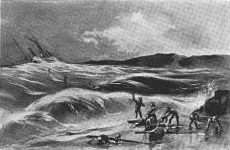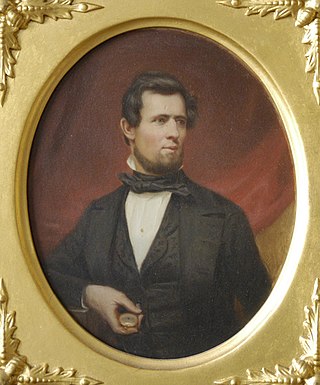Related Research Articles

The Pacific Mail Steamship Company was founded April 18, 1848, as a joint stock company under the laws of the State of New York by a group of New York City merchants. Incorporators included William H. Aspinwall, Edwin Bartlett, Henry Chauncey, Mr. Alsop, G.G. Howland and S.S. Howland.

SS Pacific was a wooden sidewheel steamer built in 1850 most notable for its sinking in 1875 as a result of a collision southwest of Cape Flattery, Washington. Pacific had an estimated 275 passengers and crew aboard when she sank. Only two survived. Among the casualties were several notable figures, including the vessel's captain at the time of the disaster, Jefferson Davis Howell (1846–1875), the brother-in-law of former Confederate President Jefferson Davis. The sinking of Pacific killed more people than any other marine disaster on the West Coast at the time.

Active was a survey ship that served in the United States Coast Survey, a predecessor of the United States Coast and Geodetic Survey, from 1852 to 1861. Active served on the U.S. West Coast. She conducted the Coast Survey's first reconnaissance from San Francisco, California, to San Diego, California, in 1852. Active sometimes stepped outside her normal Coast Survey duties to support U.S. military operations, serving as a troop transport and dispatch boat during various wars with Native Americans and during the San Juan Islands "Pig War" with the United Kingdom in 1859. She also rushed Union troops to Los Angeles, California, in 1861 during the early stages of the American Civil War.

Washington was an early steamboat operated in the states of California and Oregon. Washington was built in California and was initially operated on the Sacramento River. In 1851, the steamer was purchased and brought on a ship to the Oregon Territory, where it was operated on the Willamette River until the summer of 1853. Washington was sold again, and then transferred to the Oregon coast, where it operated on the Umpqua River, on the Coquille River and on Coos Bay. Washington was able to operate for shorter distances over the open ocean along the Oregon coast. The steamer was wrecked by a boiler explosion in December 1857, near Scottsburg, O.T., on the Umpqua river.

SS Northerner was the first paddle steamer lost in operations by the Pacific Mail Steamship Company.

Stephen William Shaw was a California '49er and portrait painter who helped discover and name Humboldt Bay and introduced viticulture to Sonoma County by 1864.

The steamer Goliah was the second tug boat ever built in the United States. The long service life of this vessel caused it to become known as the "everlasting" Goliah. This vessel was readily recognizable by its large size and sidewheels. It should not be confused with a number of other vessels named either Goliah or Goliath which were also operating as tugs. This vessel was also sometimes known as the Defender.

The California Digital Newspaper Collection (CDNC) is a freely-available, archive of digitized California newspapers; it is accessible through the project's website. The collection contains over six million pages from over forty-two million articles. The project is part of the Center for Bibliographical Studies and Research (CBSR) at the University of California Riverside.
The California Steam Navigation Company was formed in 1854 to consolidate competing steamship companies in the San Francisco Bay Area and on the Sacramento and San Joaquin Rivers. It was successful in this effort and established a profitable near-monopoly which it maintained by buying out or bankrupting new competitors. In response to the Fraser Canyon gold rush and economic growth in the Pacific Northwest, the company expanded to ocean routes from San Francisco north to British Columbia. Similarly, as California's economy grew, the company offered service from San Francisco south to San Pedro and San Diego. It exited these markets in 1867 when competition drove prices to unprofitable levels. While the California Steam Navigation Company was successful throughout its life in suppressing steamboat competition on its core Bay Area and river routes, it could not control the rise of railroads. These new competitors reduced the company's revenue and profit. Finally, in 1871, the company's assets were purchased by the California Pacific Railroad, and the corporation was dissolved.
Mohave was the first stern-wheel steamboat of that name running on the Colorado River between 1864 and 1875.
Domingo Marcucci Jugo, was a Venezuelan born 49er, shipbuilder and shipowner in San Francisco, California. He owned or captained some of the many steamships, steamboats, ferries, and sailing ships he built at San Francisco and elsewhere on the Pacific coast.
Georgiana, a small side-wheel steamboat made in Philadelphia in 1849, one of the first on the waters of the Mokelumne River, Sacramento, San Joaquin and Tuolumne Rivers of California.
Steamboats operated in California on San Francisco Bay and the Sacramento–San Joaquin River Delta, and Sacramento River as early as November 1847, when the Sitka built by William A. Leidesdorff briefly ran on San Francisco Bay and up the Sacramento River to New Helvetia. After the first discovery of gold in California the first shipping on the bays and up the rivers were by ocean going craft that were able to sail close to the wind and of a shallow enough draft to be able to sail up the river channels and sloughs, although they were often abandoned by their crews upon reaching their destination. Regular service up the rivers, was provided primarily by schooners and launches to Sacramento and Stockton, that would take a week or more to make the trip.

Black Hawk was one of three small iron-propeller driven steamboats manufactured in Philadelphia in about 1850 and shipped to the west coast of United States to be placed in river service. The other boats were Eagle and Major Redding. These boats were some of the earliest steamers to operate on the Willamette and Columbia rivers. They could carry about 12 passengers and perhaps a ton of cargo. The boats had to be small to make the run to Oregon City, which passed through the Clackamas rapids a short distance downriver from the town.

Wallamet was a sidewheel-driven steamboat that operated on the Willamette and Columbia rivers in Oregon and later on the Sacramento and San Joaquin rivers in California. Built in a Mississippi river style that was not suited to the conditions of these rivers, and suffering from construction defects, Wallamet was not a financially successful vessel. The name of this vessel is often seen spelled as Willamette.

Telephone was a sternwheel-driven steamboat built in 1884 by Captain Uriah Bonsor "U.B." Scott for service on the Columbia River. Reputedly the fastest steamboat in the world in its time, Telephone served on the Columbia River and San Francisco Bay. Telephone was rebuilt at least twice. The first time was after a fire in 1887 which nearly destroyed the vessel. The reconstructed and much larger second vessel was sometimes referred to as Telephone No. 2. The third vessel, Telephone No. 3, built in 1903 and using components from the second steamer was larger but little used during its time on the Columbia river.
El Dorado was a 153 ton side-wheel steamship, was ordered by Captain J. W. Wright and built by Thomas Collyer, it was originally to be named Caribbean, however she was sold while still on the stocks to Howland & Aspinwall, who were building up a fleet of steamers on the Atlantic Ocean.
The Kern and Sutter massacres refer to a series of massacres on March 23, 1847, in which men led by Captain Edward M. Kern and rancher John Sutter killed twenty California Indians.

Senator was a wooden, side-wheel steamship built in New York in 1848. She was one of the first steamships on the California coast and arguably one of the most commercially successful, arriving in San Francisco at the height of the California gold rush. She was the first ocean-going steamer to sail up the Sacramento River to reach the new gold fields. After more purpose-built river steamers became available, Senator began a 26-year long career sailing between San Francisco and Southern California ports. Age and improving technology finally made the ship unsuitable for passenger service by 1882. Her machinery was removed and she was converted into a coal hulk. She ended her days in New Zealand, where she was broken up sometime around 1912.
References
- 1 2 Scott, Erving M. and Others, Evolution of Shipping and Ship-Building in California, Part I, Overland Monthly and Out West Magazine, Volume 25, January 1895, pp.5-16; from quod.lib.umich.edu accessed March 10, 2015
- ↑ Nancy J. Olmsted, Vanished Waters: A History of San Francisco's Mission Bay", Mission Creek Conservancy, 1986, Chapter 7, Steamboat Point, 1851-1864 from foundsf.org accessed February 19, 2015
- ↑ George Henry Tinkham, California Men and Events: Time 1769-1890, Record Publishing Company, Stockton, 1915
- ↑ Daily Alta California, Volume 1, Number 52, 28 February 1850, P.1, Col. 3
- ↑ Daily Alta California, Volume 1, Number 127, 27 May 1850
- ↑ Tinkham, George H., History of San Joaquin County, California : with biographical sketches of leading men and women of the county who have been identified with its growth and development from the early days to the present, Historic Record Company, Los Angeles, California, 1923
- ↑ Jerry MacMullen, Paddlewheel Days In California, Stanford University Press, Stanford, 1970.
- ↑ Daily Alta California, Volume 1, Number 296, 24 November 1850 P.1 Col. 1
- ↑ Sacramento Transcript, Volume 2, Number 36, 5 December 1850 p.3, col.5
- ↑ Daily Alta California, Volume 2, Number 155, 13 May 1851 p.1 Col. 2
- ↑ Daily Alta California, Volume 2, Number 262, 31 August 1851 p. 2 Col. 3
- ↑ Daily Alta California, Volume 2, Number 300, 8 October 1851, P. 2, Col. 5, P.3, Col.3; Daily Alta California, Volume 2, Number 373, 20 December 1851, P. 2, Col. 5
- ↑ Sacramento Daily Union, Volume 2, Number 277, 10 February 1852, p.3, col.4
- ↑ Sacramento Daily Union, Volume 3, Number 373, 1 June 1852 p.2, col.2
- ↑ Daily Alta California, Volume 3, Number 146, 26 May 1852
- ↑ Sacramento Daily Union, Volume 4, Number 481, 7 October 1852
- ↑ Sacramento Daily Union, Volume 5, Number 656, 30 April 1853 p.1 col.2
- ↑ Sacramento Daily Union, Volume 6, Number 792, 7 October 1853